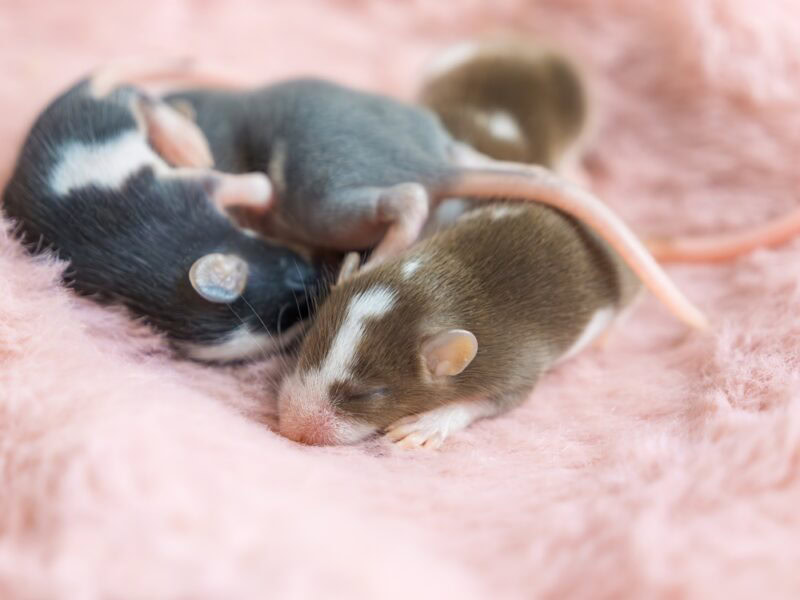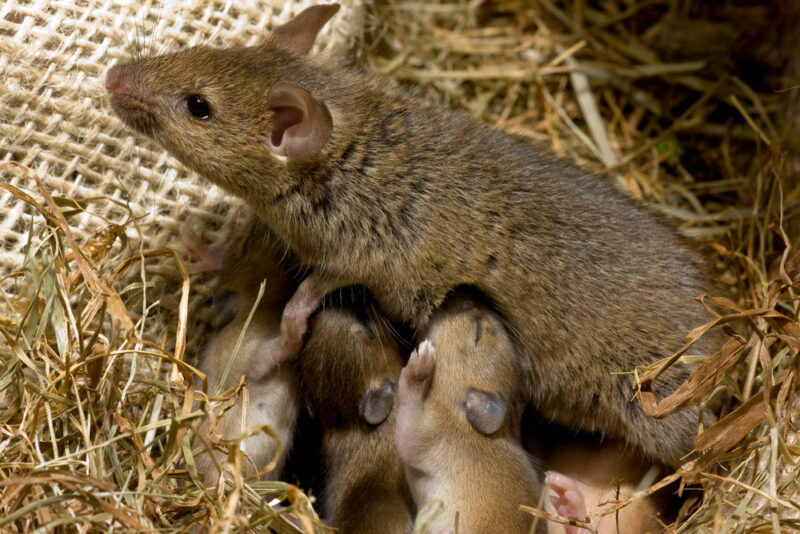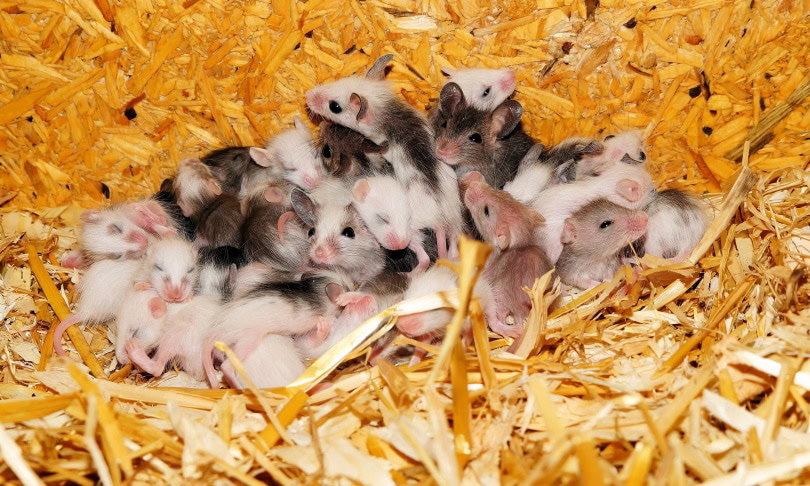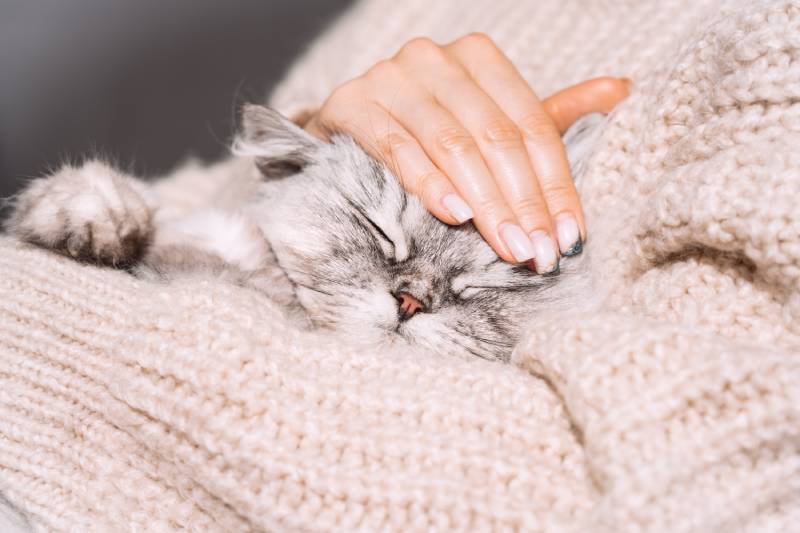Click to Skip Ahead
Mice can make pretty cute little pets, and they don’t ask much from us as their carers; a warm, secure home, clean, dry bedding, and a nice balanced diet. They’re also quite social creatures that enjoy spending time cuddled up together and generally running amok. However, if you’ve made the mistake of pairing a male and female together, you may soon find yourself feeding many more mouths than you bargained for.
With an average litter size of 10-12, two mice can rapidly become more than a dozen. Some litters will be smaller, but it’s not unusual to have litters of close to 20 pups!
Let’s take a closer look at the facts and figures of mouse reproduction so you can prepare for or prevent a population explosion!

Mouse Reproduction – The Basics
| Mice Facts | |
| Average lifespan | 18 – 24 months |
| Average breeding life | 9 – 12 months |
| Age at weaning | ~ 21 days |
| Age at sexual maturity | 6 – 8 weeks |
| Gestation period | 19 – 21 days |
| Estrous cycle length | 4 – 5 days |
| Estrus period | 10 – 20 hours |
| Average litter size | 10 – 12 pups |
When we look at the facts and figures on mouse reproduction, we can calculate that a single female mouse could potentially produce somewhere between 120 and 200 pups in her lifetime; You can see how quickly and easily a few of these little rodents can turn into a plague. Especially when you consider that female mice can become pregnant within 24 hours of giving birth!
With all this in mind, you can see why sexing and separating mice before they are 8 weeks old is pretty important. Mice are not so discerning when it comes to family relationships, and brothers, mothers, sisters, and fathers will quite happily mate.

How To Sex Newborn Mice
Being able to sort out and separate mouse pups is essential if you are planning to breed (or if unplanned breeding has occurred!). You can keep a litter together until they are 7-8 weeks old, but if you want to be completely confident, you can separate the sexes once they have been weaned (around 3 weeks of age).
As you can imagine, sexing young mice is going to be a fiddly and tricky business that might require a magnifying glass! The space between the anus and urethra is larger on a male than a female, so the easiest way to do this is by comparing pups, and keeping ‘like with like’. It’s far more challenging when viewing each mouse on their own.

Mating to Weaning – Everything You Need to Know
As we’ve discussed earlier, a female mouse can become pregnant as young as 8 weeks old. Her estrous cycle (the length of time between ovulation) is only 4-5 days, with a brief estrus period (when she is receptive to mating) of 10-20 hours. As is often the case in most mammalian species, male mice are keen to mate constantly once they have reached sexual maturity.
After a 3-week gestation period, the female will give birth to hairless, blind, and deaf young. By day 5 they start to grow a peach-fuzz layer of fur, and their ears have opened up. The eyes should be open by around day 12, and at 3 weeks after birth, the pups will look like small adults and be ready to be weaned.
As mentioned above, a female can become pregnant just 24 hours after giving birth, so it is possible that another litter may be arriving at the same time the current one is weaned!
What Does My Pregnant Mouse Need?
There have been many mouse owners who did not know about, or prepare, for a litter of pups until they arrived, and the female mouse is quite resourceful in preparing for her newborns. The most important things your pet needs are:
- A high-quality, nutritionally balanced diet
- Clean, soft bedding, preferably two different types
- Protection from becoming too cold or too hot
Mice usually like to make a nest by combining different bedding materials, so providing a mixture of paper strips, wood shavings, corn husk or other bedding types will give them the choice they need.
Factors that can lead to poor reproductive health and low litter survival rates are poor nutrition, inadequate ventilation, abnormal light cycles, cold conditions, and inadequate bedding.

Frequently Asked Questions
Should I change the bedding material in the nest?
It’s best not to disturb a mother and her babies in the first few days after giving birth, so it’s better to provide fresh material that she can line her nest with as needed. After 7-10 days, the pups will become more active, and this can be a good opportunity to remove and replace soiled bedding. Make sure the enclosure is well-ventilated, but not exposed to any draughts.
How many pups can the mother mouse feed at once?
Mice have five pairs of mammaries, so she can feed ten pups at once. If there are more than 10 pups in a litter, they will rotate around to ensure everyone gets a feed, but it’s important to keep a close eye on them to make sure everyone is growing.

Are mice good pets for children?
Mice are often thought of as a good entry-level pet, but this really isn’t the case. Although their small size and short lifespan might seem appealing to parents looking for a relatively low-maintenance pet with minimal commitment, their needs are more specialized than you might think.
Their enclosures need to be kept clean and dry, which means daily maintenance and bedding changes. Being a natural prey species, they aren’t naturally inclined to being handled by humans and are easily dropped by small hands. Many pet mice are accidentally injured or killed by rough handling, and many make a run for freedom, which can be disastrous if they start reproducing.
Although some people have quite an aversion to them, rats make far better pets of the rodent variety. They are a bit more robust, are intelligent and curious by nature, and will often seek out human contact, rather than hide away.

Conclusion
Despite their tiny size, mice are capable of producing almost 200 pups in their lifetime. With an average litter size of 10-12 pups, a short gestation period, and the ability to become pregnant almost immediately after giving birth, they certainly are a prolific species. Although mice rarely require any significant human intervention when it comes to reproduction, they do need us to provide high-quality, well-balanced food, appropriate, clean bedding material, as well as shelter and protection.
Mice become sexually mature at around 8 weeks of age, so it’s important to be able to identify and separate a litter into sexes before this happens to avoid a population boom!
See also:
- Can Mice Climb Up Walls and Stairs? What You Need To Know!
- Are Mice Nocturnal? Can They See In The Dark?
- How Long Do Mice Live? (Average Lifespan Data & Facts)
Featured Image Credit: Julia Suhareva, Shutterstock










